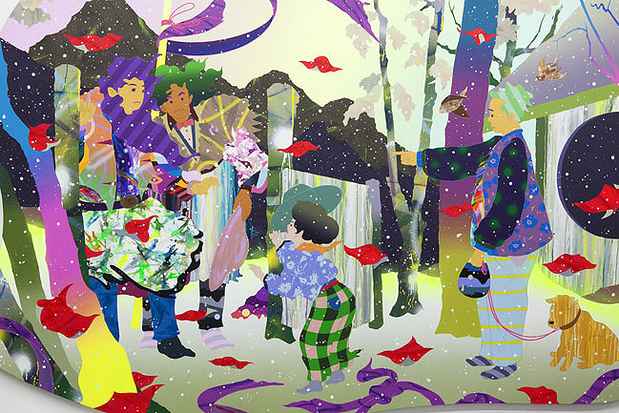"Edo Pop: The Graphic Impact of Japanese Prints" Exhibition
Japan Society Gallery

This event has ended.
The Japan Society Gallery explores the continuing generative power of Japanese popular culture in "Edo Pop: The Graphic Impact of Japanese Prints," an exhibition juxtaposing contemporary works of art with over 100 historic ukiyo-e woodblock prints drawn from one of the world’s great collections of “pictures of the floating world” at the Minneapolis Institute of Arts (MIA). In showcasing approximately 30 works by ten international artists who either draw inspiration from the ukiyo-e artists’ style, technique, or engagement in popular culture, Miwako Tezuka, the newly appointed Director of Japan Society Gallery, has recast the exhibition, which comes to New York from the MIA, where it originated earlier this year. Dr. Tezuka will feature different contemporary artists than those shown in Minneapolis, as well as 100 iconic ukiyo-e prints.
True to the chic, playful aesthetic of culture in the Edo period (1615-1868), Japan Society Gallery is commissioning AIKO, a graffiti artist based in Brooklyn, to create at the entry to the exhibition a wall-size mural that pushes her tough, urban, pop sensibility while referencing traditional ukiyo-e motifs. Other present-day artists selected, to date, to participate are Emily Allchurch (London), Paul Binnie (London), Ishii Toru (Saitama prefecture), Kazama Sachiko (Tokyo), Tomokazu Matsuyama (New York), and Masami Teraoka (Hawaii).
The Edo period was a time of great change as both artists and printers in the city (now called Tokyo) labored to satisfy the appetite for the new among a rising class of townspeople. Although color woodblock prints became affordable enough for almost everyone, low cost alone did not account for their immense popularity. Rather, as artists experimented with dramatic compositions, they also began to introduce audacious subject matter. “The subversive quality of ukiyo-e made these prints absolutely irresistible,” says Tezuka. “I see the contemporary artists we are focusing on as descendants of Hokusai, Hiroshige, Utamaro, and more of the great ukiyo-e masters represented in the exhibition.”
One of Edo Pop’s themes is 'Images of Beauty,' which is explored in juxtapositions suggesting that the role of provocateur was as familiar to ukiyo-e practitioners as it is to artists today. At the beginning of the exhibition, AIKO’s pert, liberated ‘grrls’ and a number of other images of women will be placed in close dialogue with sensual and fashionable ukiyo-e depictions of female entertainers and denizens of brothels—including Kitagawa Utamaro’s "Love for a Farmer’s Wife" (1775–96), in which a languorous beauty with a swan-like neck very discreetly allows her kimono to fall open at the breast.
A section about the realm beyond the ordinary includes ghosts, demons, mythological figures, and legendary heroes often played by Actors—ukiyo-e artists delighted in animating all these subjects, narratives, and more. As seen in Edo Pop, today’s artists are bringing a comparable visual inventiveness to their attempts to capture the vitality of life today, especially as manifested in the street and youth cultures of neighborhoods like Williamsburg or Bushwick in Brooklyn. The Brooklyn-based artist Tomokazu Matsuyama, whose neon bright, super-charged pop paintings will be featured in the exhibition, is among these emerging talents.
Further into "Edo Pop," a section devoted to the theme of 'Everyday Scenes and Products' highlights how the latest fashions, makeup, lacquers, ceramics, clocks, and pipes, as well as rare flowers, fish, and even pets figure in the worldview of ukiyo-e. A stencil print created by the London-based artist Paul Binnie in 1994 will be placed near a vertical woodblock created more than a century and a half earlier by Utagawa Kuniyoshi. Kuniyoshi’s image masterly evokes the action of a carp (koi) pushing upwards towards the surface of a lake. Binnie’s very different, noir-ish print emanates an erotic aura that is enhanced by the detail of an upwardly swimming carp tattooed onto the arm of a muscled young man.
In the 19th century, as the government loosened restrictions on travel, prompting city dwellers to take to the road in search of adventure and exotic pleasures, 'Landscapes,' too, became an important sub-genre of ukiyo-e. In Edo Pop, the British photographer Emily Allchurch will be represented by a series of photographs mounted on light boxes, each referring to a framing technique of the ukiyo-e artist Utagawa Hiroshige. By engaging with the 19th-century master’s innovations in picturing landscape, Allchurch follows such modern artists as Van Gogh and Whistler, who were also inspired by Hiroshige’s dynamic compositions. But while Allchurch’s delicate, pastel-hued scenes appear at first to chronicle the beautiful remains of old Edo, on closer inspection hints of globalization, commercialization, and urbanization intrude, along with their darker sides, including pollution and homelessness. Kazama Sachiko, a printmaker who today lives and works in Tokyo, will also contribute to this section in a large-scale black and white engravings that demonstrates how virtuosic technical mastery can be effectively placed in the service of a dyspeptic view of a warlike, violent world.
The historic prints on view in "Edo Pop: The Graphic Impact of Japanese Prints" are all masterworks, selected to convey the great breadth of ukiyo-e production and the variety of expressions of 21 of its masters. The legacy of ukiyo-e, so well represented here, is inspiration for Ishii Toru, a 31-year-old artist based in Japan. More than any other of the featured contemporary artists, Ishii, who creates pop paintings not on canvas but on silk using a method of dyeing called yuzen, has challenged himself to reinterpret the spirit of Hokusai and other ukiyo-e artists in the visual language of today.
[Image: Tomokazu Matsuyama "My Dog Can't Walk" (2012) Acrylic and mixed media on curved canvas 100 x 70 in. Courtesy of the Artist.]
Media
Schedule
from March 09, 2013 to June 09, 2013